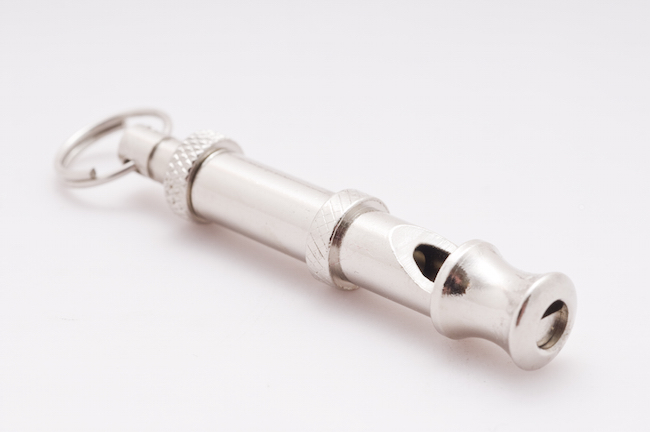
Each pet parent has their own unique way of calling their dog. Some clap and shout, “Here boy!” while others sing out the dog’s name, or whistle through their teeth. One strategic method of getting a dog’s attention is to use a high-frequency whistle. Though you will not hear anything louder than a hiss, your dog’s ears will perk up right away!
High Frequency Whistles
The first high-frequency dog whistle was created by Sir Francis Galton in 1876, who was attempting to study the ranges of frequencies dogs are able to hear. A dog’s ears have a more extensive hearing capacity than we do. They can pick up sound waves that are completely inaudible to humans, whose ears can only detect up to 20 kHz. Most high-frequency dog whistles range anywhere from 23-55 kHz, allowing the pups to catch the note from great distances away. The use of high-pitched sound emitters can help to warn a dog, correct bad behaviors, or call him home. Most whistles have adjustable settings that allow you to change it from low or high pitch sounds, from pleasant (encouraging/beckoning) sounds, to irritating (discouraging/corrective) noises. This will allow the whistle to function both as a summons as well as an obedience training tool.
Most of the whistles are powered by breathing through the device, or can be triggered by piezoelectric emitters that sound an ultrasonic tone by the click of a button. These ultrasonic devices function similarly to those that form property barriers or discourage dogs from barking. High frequency sounds in ultrasonic whistles are a helpful way to communicate with your pet while in noisy areas where a human voice wouldn’t carry, or when one does not wish to disrupt their neighbors. The ultrasonic whistles are also a favorite tool among hunters who can signal or call their dogs without disturbing the sport or alerting the prey.
Whistle Training
The most effective training is command related, as it teaches your dog to rely on your spoken instructions alone. However, high frequency whistles can be useful tools in the training process, not only to convey a point, but rather as a helpful reinforcement for good behavior. While whistle training, the owner must begin by standing in a separate room and blowing the whistle. When the dog arrives to find out what is going on, reward him with a treat. Practice summoning the dog to you with the whistle at various distances, always producing a tasty morsel on your pup’s arrival. Continue this process until your dog routinely will come to you at the whistle’s sound, no matter how far you are.
Using different sound cues on the ultrasonic whistle will help train your dog about what actions to stop and what commands to follow. For example, by only using the negative/unpleasant tones when he does something amiss, the pup will quickly learn that bad behaviors result in jarring noises, while obedience results in a treat. Whatever use you find for the “silent” dog whistle, working with your dog to establish clear commands and responses will cause communication in training to improve.
Many pet-owners and dog trainers have found the high-frequency dog whistles to be a beneficial alternative to standard pea whistles and sound clickers. And for those app-happy pet-owners, rest assured, there are now ultrasonic dog whistle apps available for download on mobile devices!

